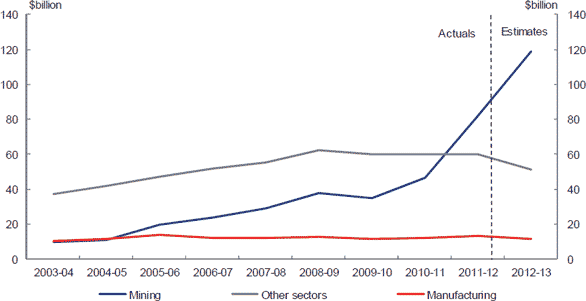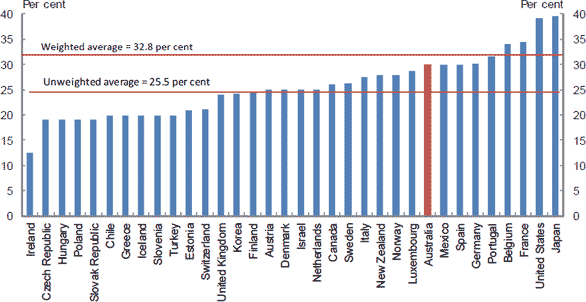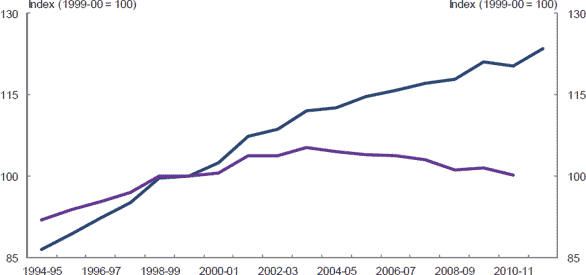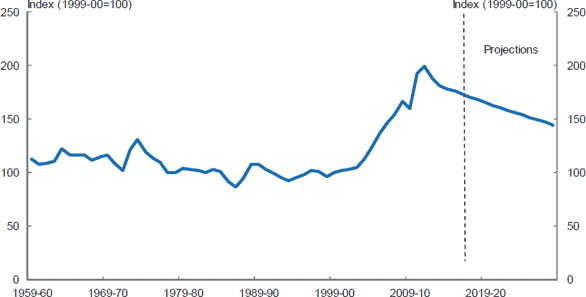A principled approach to business tax reform
- In considering how to approach business tax reform within its terms of reference, the Working Group developed the following set of principles:3
- Revenue adequacy: The business tax system should raise revenue that, together with other taxes, helps to pay for public services that the community relies upon.
- Economic efficiency: The business tax system should raise revenue in a way that minimises the effect of the tax system on business decisions except where this is needed to correct for market failures.
- Competitiveness: The business tax system should take into account Australia's integration with the global economy.
- Distributional equity: The business tax system and potential reforms should be understood in terms of where the final incidence falls among capital owners, workers and consumers.
- Simplicity: Business tax reform should be aimed at making the system as simple and as easy to comply with as possible, having regard to an often complex business environment, the need to ensure the integrity of the system and the costs and benefits of transitioning to any new rules.
- New investment focus: Business tax reform should generally focus on new investment.
- The application of these principles underpinned the proposition put in the Discussion Paper that there were economic benefits from a lower company tax rate. The Working Group's further consideration of the issues, supported by the broad consultation undertaken by the Working Group, has confirmed its view.
A lower company tax rate to promote investment
- A lower company tax rate has consistently been regarded as central to Australia's international competitiveness through its attractiveness as an investment destination.
- As a result of base broadening business tax reform, the company tax rate has been reduced from 46 per cent in the mid-1980s to the current rate of 30 per cent. This included the outcomes from the Asprey Review and the Review of Business Taxation, which recommended the removal of a number of business tax concessions to fund a lower company tax rate. The AFTS Review recommended among other things, that the company tax rate be reduced to 25 per cent over the short to medium term with the timing subject to economic and fiscal circumstances and conditional on improved arrangements for charging for the use of non-renewable resources.4 These reviews advocated a lower rate to encourage capital flows considered crucial for Australia's long-term investment prospects, economic growth and employment.5
- This advocacy reflects Australia's dependence on international capital markets to respond to investment opportunities, a dependence that is unlikely to change in the future. Australia's capacity to compete effectively for these flows will be crucial to financing new investment in the long term. A company tax rate reduction could assist businesses to more easily fund investment opportunities through capital markets by lowering the pre-tax required rate of return for investors.
- Australia currently has high levels of foreign direct investment and a substantial pipeline of investment, particularly in mining. Indeed, Australia is currently experiencing unprecedented levels of investment activity with new capital expenditure in the mining sector during 2010-11 being nearly four times the average annual expenditure of the past 30 years.6
- As illustrated in Chart 1, however, this growth is not being experienced uniformly across the economy, with investment in the mining sector far exceeding new investment in manufacturing and other sectors. As the production capacity of Australia's mining sector becomes established the growth in mining sector investment is expected to moderate. As this occurs it will be increasingly important that other sectors within the economy are able to attract investment to maintain Australia's economic growth. A lower corporate tax rate could attract foreign investment in industries that are currently struggling with difficult domestic and international economic conditions as well as providing a better environment for investment in the longer term.
Chart 1: Capital Expenditures by sector (2003-2013)

Source: ABS catalogue 5625.0
- 18. Australia's ability to attract investment is also affected by the company tax rates that apply in other countries. Australia's company tax rate is below the OECD weighted average, but is above the unweighted average and higher than most other OECD countries (see Chart 2). This does not, however, take into account that different countries provide shareholder relief on dividend income in different ways, which can influence the overall level of tax paid on company profits across the entire tax system. For example, tax relief is provided for domestic investors under Australia's dividend imputation system.
Chart 2: Company tax rates of OECD countries (2012)

Source: OECD tax database (2012) and weightings calculated using figures sourced from the IMF World Economic Outlook Database (2011).
- In addition, many OECD countries have plans to further reduce their company tax rates. In recent budgets, the United Kingdom (UK) and Canadian governments reaffirmed plans for further corporate tax rate reductions. The UK corporate tax rate has been reduced from 26 to 24 per cent in 2012, and is expected to be further reduced to 23 per cent in 2013 and to 22 per cent in 2014. Canada, which has cut its federal rate from 18 to 16.5 per cent in 2011, will lower this further to 15 per cent. The Canadian Government has also called for provincial corporate tax rates to be reduced. The combined federal and provincial corporate tax rate in Canada ranges between 25 per cent and 31 per cent.
- Theory suggests that a lower statutory rate and resulting lower effective average tax rate (EATR)7 should enhance the incentives for multinational firms to invest in Australia. Statutory tax rates and EATRs have been found to be significant determinants of investors' choices of location for investments.8 Increased economic globalisation has enhanced the prominence of location choice in multinationals' decision making processes. The AFTS Review cited evidence that on average a one percentage point increase in the rate of tax would result in a decrease in foreign direct investment of 3.72 per cent.9 To the extent that a firm's value is tied to the value of its intellectual property, a firm is able to minimise its overall tax liability by basing such intangible assets in a country with a low statutory tax rate. Accordingly, reductions in the Australian corporate tax rate can affect marginal location choices.
- Compared to purely domestic entities, multinational firms enjoy greater freedom and range of choice in their decision of where to locate production, making them more responsive to corporate tax rates. Of course other factors also contribute to a country's attractiveness as
an investment destination, such as access to materials and the quality of the labour force. - A lower statutory company tax rate could also make Australia less susceptible to profit shifting by multinationals. Changes in how business is undertaken have increased the ability of multinationals to shift profits to countries that offer the most favourable tax regimes. Profit shifting practices have been spurred by the increasing share of economic activity for which multinational corporations are responsible.
- Comparisons of statutory tax rates do not, however, say anything about the effective tax rate that the investment bears because tax bases also differ considerably between countries. As rates have been cut, bases have been broadened. In many cases, countries have opted to reduce or eliminate accelerated depreciation allowances in order to more closely align allowances with economic rates of depreciation. Between 1982 and 2005, 11 OECD countries reduced their tax depreciation rates for investment in plant and machinery. Allowances for intangibles, plant and machinery and especially buildings have all become less generous in the past two decades. Some countries have also funded tax rate cuts by abolishing their dividend imputation systems.
- In considering the rate of company tax that should apply, attention also needs to be paid to the key function of tax, which is to raise revenue. The business tax system should contribute to the revenue that is necessary to pay for the public services that the Australian community relies upon. The competitiveness of Australia's company tax rate therefore needs to be considered alongside its ability to contribute to revenue adequacy. Considerations such as the level of complexity of the tax system and the efficiency of the tax administration will also play a part.
The company tax rate and productivity
- A lower company tax rate is one way that business tax reform could contribute to an improvement in the economy's productivity performance, which is a key to facilitating continued economic growth.
- While Australia's productivity levels are high, lifting our productivity performance will be a key driver of future prosperity. In particular, Australia's future economic growth will increasingly depend on its ability to improve how labour and capital are combined in production. Chart 3 illustrates how Australia's multifactor productivity, which measures how well the economy as a whole is combining capital and labour into production, has been stagnating over the past 15 years.
Chart 3: Market sector productivity in Australia (1994-2012)

Source: Dolman & Gruen (2012) and ABS Cat. 5206.010
- Australia's weak multifactor productivity growth has been exacerbated by the pressures exerted on those firms that find themselves in the 'slow lane' of the two-speed economy, however, overcoming this issue is of even greater importance when considering that the current high terms of trade and rate of investment in mining industries are moderating.
- The growth of Asia has significantly increased the worldwide demand for natural resources and fuelled the investment in the mining and mining-related sectors of the Australian economy. This has created considerable adjustment pressures for Australian exporters in non-mining sectors, such as manufacturing, tourism and education. The high terms of trade and corresponding high Australian dollar (see Chart 4) have reduced the international competitiveness of these sectors by increasing the price that other countries pay for our goods and services. These factors are contributing to Australia's patchwork economy - with growth unevenly distributed across all sectors.
Chart 4: Australia's terms of trade

Source: Dolman & Gruen (2012)
- A lower company tax rate can improve productivity by increasing the level of capital in the economy. By reducing effective marginal tax rates (EMTRs),11 a lower company tax rate can reduce a project's hurdle rate of return. As a result, more investments will be undertaken. As the quantity of investment in the economy increases, there is an increased level of capital in the economy. Greater quantities of capital will enhance the marginal productivity of labour, resulting in an increase in productivity, economic growth and incomes.
- A reduction in the company tax rate would also reduce distortions in the tax system relating to financing decisions and depreciation. The tax system favours debt over equity financing by providing a deduction for interest payments on debt but not a return for shareholders on equity. In addition, the tax system does not perfectly align tax depreciation with economic depreciation (such as through accelerated depreciation provisions and the immediate expensing of some intangibles), which can distort business investment choices. Reducing the company tax rate would reduce the extent of both these distortions and result in a more efficient allocation of capital.
- Estimates of the marginal welfare loss from different taxes suggest that company tax at its current rate is a relatively inefficient vehicle to use as an incremental source of tax revenue.12
- The benefits of a lower corporate tax rate would be dynamic rather than static. In the short run, a lower corporate tax rate should predominately benefit capital owners in the form of enhanced levels of profitability.13 Such higher rates of return may be reinvested within the business or distributed to shareholders. However, a reduction in the company income tax rate would also increase the after-tax return on investment, encouraging more investment and thereby enhancing the capital to labour ratio within the economy. This process of 'capital deepening' could increase the marginal product of labour, resulting not only in higher economic growth but also higher wages in the long term.14 In the long run some of the incidence of a lower company tax rate would also be captured by capital owners earning location-specific profits, such as those within the resources industry.15For other non-resident investors the investment induced by the lower company tax will in the long run drive down the pre-tax return so that these investors end up with about the same after-tax return.
- Consistent with the principle of revenue adequacy, the business tax system should raise revenue that, together with other taxes, helps pay for public services that the community relies on, including investment in infrastructure, research and education, which can also support productivity.
Economic impact of cutting the company tax rate
- Treasury modelling commissioned by the Working Group indicates that a reduction in the statutory company tax rate from 30 to 29 per cent would increase gross domestic product (GDP) and household consumption in the long run. Further details of the model and key assumptions can be found at Appendix B.
- Importantly, the modelling assumes that the cut in the company tax rate is offset by a reduction in lump sum transfers to households to keep the government budget balanced. This is a standard technical
assumption. The benefit of potential policy reform packages would, of course, depend upon how the rate reduction is funded. - The modelling suggests that a company tax cut of this size would increase the level of GDP by 0.2 per cent compared with what would otherwise be the case.16 This increase in GDP is driven mainly by greater foreign investment flows into Australia to fund additional projects that are made viable by the reduction in the tax rate. Under reasonable assumptions in the model, additional capital investment increases the capital stock by 0.3 per cent.
- The modelling also suggests that Australian workers benefit from the company tax cut in the long run. The productivity of labour increases with the increase in the size of the capital stock and this flows through to an increase in after-tax real wages of 0.2 per cent and a small increase in labour supply of around 0.1 per cent. Overall, the modelling shows that cutting the company tax rate can deliver an improvement in consumption by Australian households of around 0.05 per cent.17
- As noted above, the Working Group considers that a cut in the company tax rate of two to three percentage points would be needed to drive a significant investment response. The impact of a cut of two (or three) percentage points would be expected to be slightly less than double (or triple) the impact from a one percentage point cut.
3 The full text of the principles is provided at Appendix A.
4 AFTS Review (2009), Final Report to the Treasurer, Treasury, Canberra (recommendation 27).
5 Review of Business Taxation (1999), Review of Business Taxation: A Tax System Redesigned, Treasury, Canberra, p 24. AFTS Review (2009), Final Report to the Treasurer, Treasury, Canberra, p 169.
6 New, R., Ball, A., Copeland, A. (2011), Minerals and energy. Major development projects – April 2011 Listing, Australian Bureau of Agricultural and Resource Economics and Sciences, Canberra.
7 EATRs measure the proportion of an investment that is paid in tax. EATRs affect location decisions such as where to locate investment and where to locate profits.
8 Altshuler, R., Grubert, H., & Newlon, T. (2000), 'Has U.S. Investment Abroad Become More Sensitive to Tax Rates?', International Taxation and Multinational Activity, National Bureau of Economic Research. Devereux, M (2003), 'Evaluating Tax Policy for Location Decisions', International tax and public finance, vol. 10, no. 2.
9 AFTS Review (2008), Architecture of Australia's tax and transfer system, Treasury, Canberra, p 296.
10 Data are for 16 market sector industries. Data are not available for 2011-12 multifactor productivity.
11 EMTRs measure the effect of tax on the return to an investment that just breaks even or covers all of its economic costs. EMTRs affect a business's choice of how much to invest in a project.
12 AFTS Review (2009), Final Report to the Treasurer, Treasury, Canberra, p 13.
13 More specifically, the short-term beneficiaries of a rate cut would be non-resident shareholders, as any gain to domestic shareholders would be offset through the dividend imputation system.
14 AFTS Review (2009), Australia's Future Tax System, Treasury, Canberra, p 166.
15 Henry, K. (2009), A Tax System for Australia in the Global Economy, speech to the Australian Business Tax Reform in Retrospect and Prospect colloquium, Sydney, 23 February 2009.
16 A reasonable working assumption may be that half of the change in the economy will occur within approximately seven years, and the adjustment will be largely complete within 20 years.
17 Consumption in this context is a measure of the volume of consumption of goods and services as well as leisure time enjoyed by Australian households.